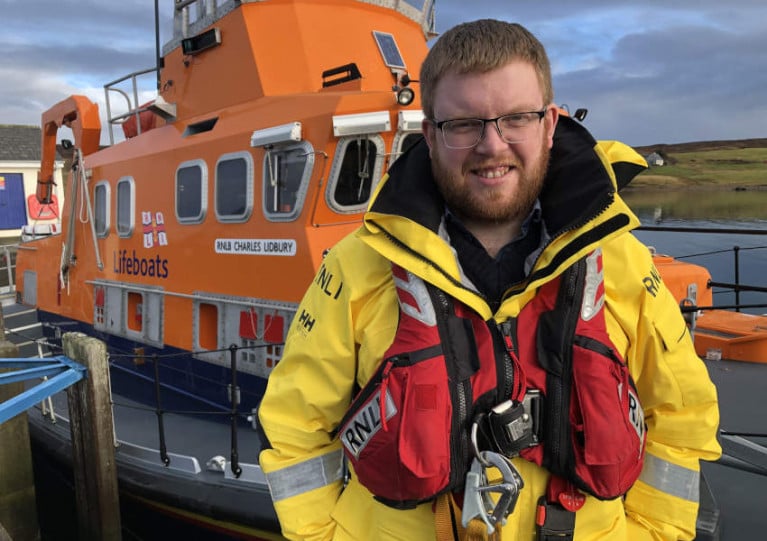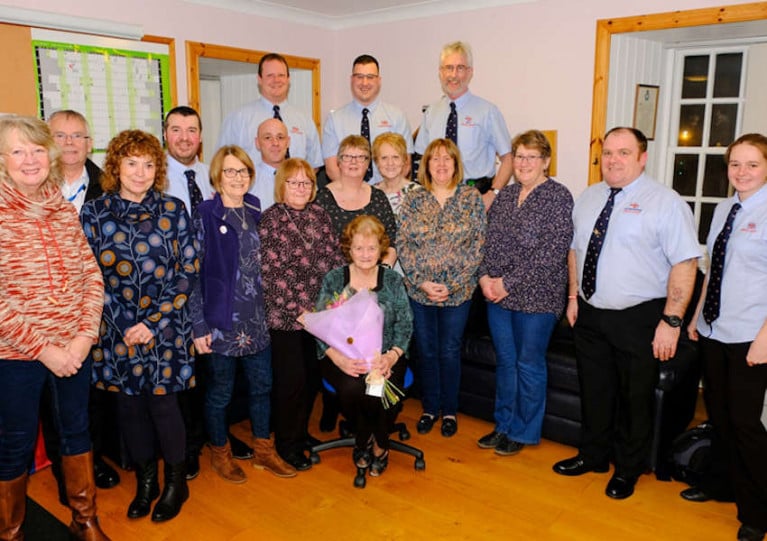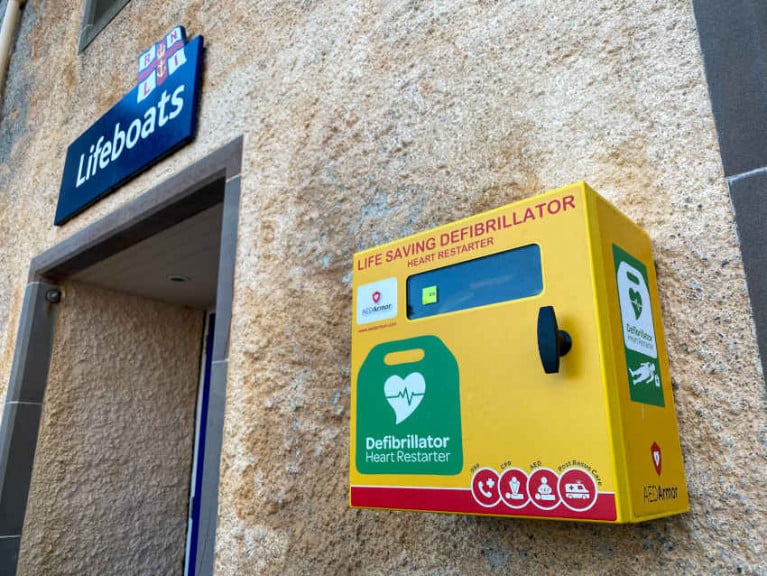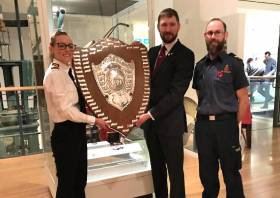Displaying items by tag: Shetland Islands
Shetland Fishing Boat Towed Off Rocks In Early Morning Rescue
A local Shetland fishing trawler is now safely back in harbour after briefly running aground near Trondra in the early hours of yesterday morning (Saturday 21 March).
The 26m whitefish trawler Sedulous had five crew on board when it went ashore around the north end of the island as it was leaving Scalloway Harbour for fishing grounds to the west of the Scalloway Islands, just after 3.30am.
Seven volunteers from Aith Lifeboat Station responded to the emergency call, and reached the site of the incident before 5.20am onboard the RNLI Charles Lidbury.
Another local trawler, the Radiant Star, was already in the area and had offered its assistance, along with Scalloway Harbour pilot boat Lyrie.
After waiting for the tide to rise, the Radiant Star crew were successful in establishing a tow line with Sedulous, and managed to pull the boat back to deeper water before any serious damage was done.
The Sedulous was then able to return to port in Scalloway under her own steam, escorted by the RNLI Charles Lidbury, and the Aith lifeboat returned to station by 8am.
Aith RNLI lifeboat coxswain John Robertson said: “Life-threatening incidents can happen at sea at any time. So it’s important that you call for help when something goes wrong.
“I’d like to thank the crew of the Radiant Star for their safe and essential assistance this morning. Their quick, competent response was an important part of getting Sedulous and her crew back to safety.
“Local RNLI crews are always ready to respond, and I’m pleased that we once again assembled so many volunteers so quickly.”
John added: “This was our first callout since the recent outbreak of the coronavirus in Shetland, at a time when many folk are self-isolating or social distancing.
“Helping slow the spread of this virus ensures that our volunteers remain healthy, and are able to keep helping save lives at sea.”
The RNLI lifeboat stationed in Aith in the Shetland Islands is to be led by local man John Robertson.
He has been appointed by the lifesaving charity as coxswain of the RNLI Charles Lidbury, the regular lifeboat stationed in the village — and will lead the volunteer crew at the most northerly lifeboat base in the UK, right on the edge of Scottish waters.
John (31), who has been the vessel’s full-time mechanic since August 2013, lives in Aith with his family, and was selected for promotion by the RNLI after formal assessments and interviews.
He has taken on the role under supervision, until his final coxswain training is completed in the coming months.
John’s years of service with the RNLI have included being called out to several notable incidents at sea.
His first ever shout was to the fatal sinking of the scallop boat Diamond near the West Burrafirth pier in March 2014, when RNLI volunteers managed to rescue a surviving crew member from the water.
He was also part of the team that attended the rescue of the Edward Henry, the crab fishing boat that was hit by a large wave west of Sumburgh in March 2017 — smashing wheelhouse windows and knocking out engines and electronics.
John and the rest of the RNLI Charles Lidbury crew spent around 14 hours at sea, escorting the damaged vessel to safety through Force 9 winds and heavy seas.
John says that the “time was right” for him to apply for the job of coxswain, and is “feeling good” about the prospect of managing the RNLI station in Aith.
His predecessor, Adam James, has moved to the north of England to take up a job as coxswain with the RNLI's operation on the Humber river near Hull.
John says: “Aith is a settled station with an experienced crew already in place. It was the trust of that crew that encouraged me to apply for the job of coxswain, and that trust is essential.
“Aith is a relatively quiet station, but our callouts tend to be serious, lengthy and often in testing weather conditions. We need to work well as a team in order to save lives at sea — and I’m really looking forward to stepping up and leading that team of committed local volunteers.
“Time is of the essence whenever we launch the RNLI Charles Lidbury, as we try to launch our lifeboat within seven minutes of our pagers going off. That can be quite a tie. I'll tend not to go any further away than Bixter, unless cover has been pre-arranged.
“But this will be a good job for me and my family, and allow me to be home about — pager depending — in between all the paperwork and maintenance that comes with running a lifeboat station.”
John is originally from Voe, but has a family connection to the lifeboat through his wife Kayla whose grandfather Frank Johnston served as lifeboat mechanic for many years, and attended the famous rescue of the crew of the Juniper trawler in February 1967.
Johnston's service that day earned him the RNLI’s Thanks of the Institution inscribed on vellum.
Lerwick Lifeboat Guild Fundraising Volunteer Steps Down After 38 Years
Bella Irvine has retired from the Lerwick Ladies Lifeboat Guild after 38 years service, since first volunteering for the Shetland Islands RNLI unit in 1982.
At a gathering at RNLI Lerwick lifeboat station to mark the occasion last Tuesday evening (4 February), members of the guild and current lifeboat crew members paid tribute to Bella’s contribution on the committee.
After her first 10 years, Bella was then treasurer for 23 years, from 1992 until 2015. Since then, she has continued to support fundraising events and activities, including volunteering in the RNLI Lerwick shop.
In recognition of her long service, Bella received a RNLI Gold Badge and Bar in 2016.
The guild raises funds for the RNLI towards the operational costs of the Lerwick lifeboat in Scotland's far nothern isles, which relies entirely on public donations.
‘She’s one in a million and will always be welcome in our shop, where she will always find the kettle on’
Throughout the year, the guild organises many events, including the popular Lifeboat Open Day in midsummer and the Lifeboat Ball later in the year. Committee members also attend country shows during the summer months to generate income and to raise the profile of the RNLI.
In 2019, the Lerwick Lifeboat Guild, including funds raised by the men’s committee, raised a total of over £44,000.
Rhoda Watt, joint chair of the Lerwick Ladies Lifeboat Guild and current treasurer, said: “Bella has been absolutely dedicated beyond measure and will be missed on our committee. She’s one in a million and will always be welcome in our shop, where she will always find the kettle on.”
Malcolm Craigie, RNLI Lerwick lifeboat operations manager, said: “The RNLI relies on dedicated fundraisers across the country to provide equipment and training for our volunteer crews, so that we’re ready to respond 24 hours a day.
“On behalf of the lifeboat crew, we’re hugely grateful to Bella for everything she has done for the Lerwick Lifeboat Guild over the last 38 years.”
Defibrillator Installed At Lerwick Lifeboat Station
A cardiac defibrillator has been installed outside Lerwick RNLI’s lifeboat station, to provide essential lifesaving treatment to anyone suffering from a heart attack.
The defibrillator is fitted in a highly visible protective cabinet outside the station door next to the small boat harbour, which is a popular spot for locals and visitors in Scotland’s Shetland Islands throughout the year.
Accessible 24 hours a day, providing an emergency asset for the area, the automated external defibrillator (AED) can monitor the heart rhythm and, if necessary, deliver an electric shock to the heart, which is the most effective treatment for a heart attack.
AEDs can be used by anyone, without the need for any specialist training, as any rescuer will be guided through what to do by the voice commands and display panel.
The defibrillator has been part-funded by a grant from the British Heart Foundation, and a local crowdfunding effort raised the extra money required to purchase the equipment and stainless-steel cabinet necessary to house it.
Lerwick lifeboat crew are particularly thankful to one anonymous donor who gave £900 to the appeal.
Scottish charity Lucky2BHere, which has helped to provide many defibrillators in Shetland, has also provided AED training to the lifeboat crew.
It is thought that next nearest public access defibrillator is around 400 metres away, outside the Stewart Building, while the nearby Lerwick Boating Club has a defibrillator located in their premises.
Darren Harcus, coxswain of RNLI Lerwick, said: “Installing this defibrillator fits well with our function as the charity which saves lives at sea. This will be an important lifesaving asset for the Lerwick waterfront, partly paid for by the local community.
“We’d like to thank all those who have made donations for this defibrillator, the British Heart Foundation who have provided grant funding, Lucky2BHere who have provided support, and our RNLI Estates Team who have dealt with the necessary paperwork to install and provide electrical power to the defibrillator on the building.”
Lerwick Lifeboat Aids Crew Of Grounded Vessel
Lerwick lifeboat launched late Friday night (15 November) to the aid of a fishing vessel which had grounded on rocks just north of the Shetland Islands harbour.
The 26-metre, Inverness-registered trawler was stuck fast and was listing when the Severn-class all-weather lifeboat arrived on scene around 1.40am.
Lerwick Port Authority vessels Knab and Kebister, and the fishing vessel Faithlie, also arrived soon after to assist.
After assessing the damage, attempts by the lifeboat crew to tow the vessel off the rocks on a falling tide were unsuccessful, with two tow lines on the lifeboat snapped in the effort. The other vessels on scene were also unable to free the trawler from the rock.
The nine crew members were taken off the stricken vessel by the lifeboat around 4am and safely returned to Lerwick Harbour, with only minor injuries, and into the care of the ambulance service.
Weather conditions were calm with light winds and a moderate sea swell, with the air temperature just above freezing.
Around 12 hours later, the lifeboat returned to the scene to assist with another attempt to refloat the vessel at high tide, just before 1pm on Saturday.
The Knab and Kebister were successful in pulling the vessel off the rocks on Saturday afternoon and took the vessel under tow into Lerwick Harbour, accompanied by Lerwick lifeboat.
Lerwick RNLI’s deputy coxswain Tommy Goudie said: “The outcome of this grounding could have been a lot worse. Thanks to fair weather and the combined efforts of ourselves and Lerwick Port Authority vessels, the fishing crew are safe, and the vessel is now safely in harbour.
“The crew did the right thing by contacting the coastguard as soon as they knew they needed help. They were wearing survival suits and life jackets and deployed their life raft in case it became necessary. Our crew are always ready to respond and we’re pleased to be able to assist.”
Rescue Shield Awarded To Shetland-Based Coastguard Teams
HM Coastguard rescue teams from Lerwick, Hillswick and Sumburgh, the search and rescue helicopter crew from Sumburgh and staff from the Coastguard Operations Centre in Shetland have been awarded the prestigious UK Department for Transport Rescue Shield by Brian Johnson, chief executive of the Maritime and Coastguard Agency (MCA), for a dramatic cliff rescue 18 months ago.
The DfT Rescue Shield is the highest national accolade in the United Kingdom awarded to coastguard teams which have performed the most outstanding rescue of the year. The presentation last Tuesday 5 November marks the sixth time that Shetland-based teams have been awarded the shield.
On the evening of 9 May 2018, a teenager was trapped at the base of a 120ft cliff for two hours with the tide coming in, in Fethaland, Shetland, after attempting to scale it.
The rescue was challenging and its success was due to the professionalism and teamwork of all involved in a rescue co-ordinated by HM Coastguard.
Coastguard rescue teams navigated difficult terrain in appalling conditions on the narrow headland, setting up cliff rescue equipment before one of the team descended the cliff, enduring storm force winds, rain and heavy squalls from the incoming tide to safely recover the casualty to the top of the cliff.
“As emergency response teams we rely heavily on each other to achieve success and this case was a prime example of that,” said Dave Sweeney, senior coastal operations officer.
“It was a challenging rescue and we needed all our teams’ shared expertise and resources to safely rescue the man. It was teamwork at its best.
“We are honoured to be awarded for our efforts on this particular rescue and it’s a mark of recognition for all the work and dedication of the front line volunteers, paid crew members and behind the scenes teams that help us all save lives together.”
St Brendan Voyagers Refused Access to Skellig
The crew of sailors, artists, musicians and historians on board Ar Seachrán - who are retracing the famous voyage of St Brendan - were refused permission to land on Skellig Michael, it has emerged.
The Kerryman reports that though some visitors are understood to have landed on the island in recent weeks, the OPW refused the Brendan's Voyage crew on health and safety grounds.
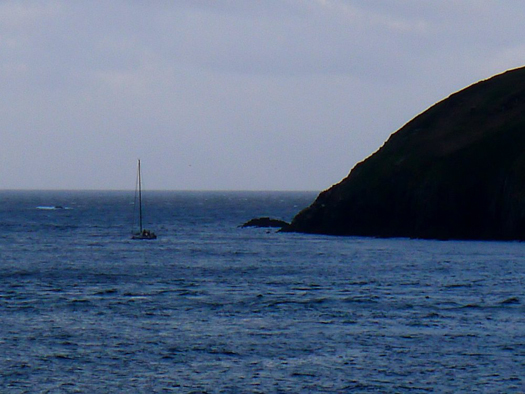
A spokesperson for the OPW said it requires at least 10 days notice to make preparations for any visitors and repair damage to pathways and buildings occurring over the winter months.
Dr Breandán Ó Ciobhán of the voyage party described the news as "very disappointing".
Ar Seachrán, a 45ft yacht owned by Paddy Barry - himself a veteran of unique ocean voyages - will continue on its journey up the west coast of Ireland and Scotland, by the Orkneys, Shetlands and Faroe Islands to Iceland.
British Coastguard Fears Loss of Choppers
The union representing coastguard staff in the UK has expressed its fears over the loss of air rescue services when a number of helicopters are transferred to Ireland next year.
Under CHC's €500m contract to provide search and rescue services for the Irish Coast Guard, four helicopters will be withdrawn from England and Scotland for redeployment in Ireland.
However, HeraldScotland reports that the Maritime and Coastguard Agency (MCA) has no plans to replace these helicopters, which separately service Scotland's Isle of Lewis and Shetland Islands as well as the Solent and Portland in England.
The recent collapse of the privatisation deal for UK search and rescue services has meant there is no new operator lined up to replace CHC.
Jeremy Gautrey of the PCS union said that the situation "has now potentially left the coastguard service stranded without the guarantee that it will have sufficient helicopters to carry out search-and-rescue operations when the current helicopters retire."
HeraldScotland has more on the story HERE.



























